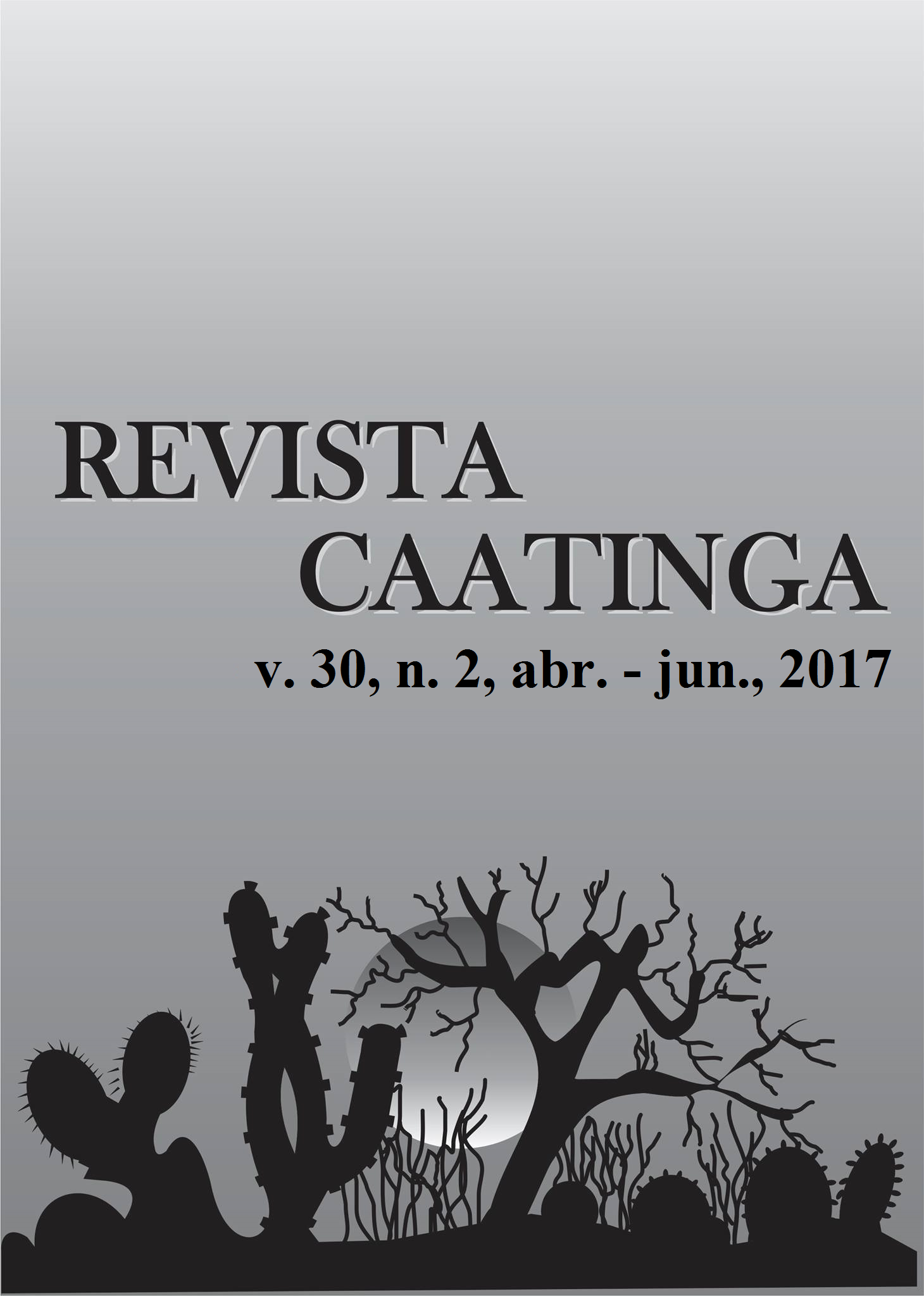PRINCIPAL COMPONENTS OF THE INTENSITY OF SQUAMOUS ROT ON PRICKLY PEAR PLANTATIONS IN THE SEMIARID REGION OF THE STATE OF PARAÍBA, BRAZIL
DOI:
https://doi.org/10.1590/1983-21252017v30n212rcKeywords:
Opuntia ficus-indica. Progress of plant diseases. Epidemiology.Abstract
The aim of the present study was to identify fungal pathogens associated with prickly pear rot and the main components of squamous rot on plantations in the semiarid region of the state of Paraíba, Brazil. Pathogens were identified morphologically. The determination of the main components of squamous rot intensity was based on the incidence and severity of the disease. Fifteen genera of fungi were associated with rot, including Scytalidium sp., which was found on all plantations. The analyses indicated that relative humidity and rainfall favored the intensity of rot more than temperature. At least three pathogens were found to be associated with a high incidence of rot in prickly pear species in the semiarid region of the state of Paraíba, Brazil, but Scytalidium sp. was the most widely distributed. Moreover, the disease caused by this fungus intensifies and progresses under conditions of high humidity at moderate temperatures.Downloads
References
BERGAMIN FILHO, A.; AMORIM, L. Doenças de Plantas Tropicais: epidemiologia e controle econômico. 1. ed. São Paulo, SP: Agronômica Ceres, 1996. 299 p.
BONFIM, A. G. L. et al. Fungos fitopatogênicos de Opuntia ficus-indica (L.) Mill. cultivada em área de floresta tropical seca no Brasil. In: Boletím de la Sociedad Latinoamerica e del Caribe de Cactáceas e Otras Suculentas, Mendonza, v. 10, n. 2, p. 27-33, 2013.
CAMPBELL, C. L.; MADDEN, L. V. Introduction to plant disease epidemiology. New York: Wiley, 1990. 532 p.
CANTWELL, C. F. M. Postharvest management of fruits and vegetables stems. In: BARBERA, G.; INGLESE, P.; PIMIENTA-BARRIOS, Y. E. (Eds.). Agro-ecology, cultivation and uses of cactus pear. Rome: FAO Plant Production Paper, v. 132, p. 12 –143, 1995.
CHALFOUN, L. G.; LIMA, R.D. Influência do clima sobre a incidência de doenças infecciosas. Informe Agropecuário, v. 12, p. 31 – 36, 2006.
CROUS, P. W. et al. Phylogenetic lineages in the Botryosphaeriaceae. Studies in Mycology, Utrecht, Netherlands, v. 55, n. 1, p. 235–253, 2006.
DESAI, J. D; RAY, R. M; PATEL, N. P. Purification and Properties of Extracellular 0- Glucosidme from Scytalidium lignicola. Biotechnology and Bioengineering, Berkeley, CA, v. 25, n. 1, p. 307 - 31, 1983.
DUQUE, J. G. O nordeste e as lavouras xerófilas. 4. ed. Fortaleza, CE: Banco do Nordeste do Brasil, 2004. 330 p.
JOLLIFFE, I. T. Principal component analysis. New York, NY: Springer-Verlag. 2. ed. 2002. 487 p.
LOPES, E. B. et al. Palma forrageira: cultivo, uso atual e perspectivas de utilização no Semiárido Nordestino. João Pessoa, PB: Emepa/Faepa, 2012. v. 1, 256 p.
MCKINNEY, H. H. Influence of soil temperature and moisture on infection of wheat seedlings by Helminthosporium sativum. Journal of Agricultural Research, Washington, DC, v. 26, n.9, p. 195-217, 1923.
OREN, Y. et al. Scytalidium wilt of citrus. European Journal of Plant Pathology, Netherlands, v. 107, n. 1, p. 467–470, 2001.
ROSSMAN, A. Y. et al. A literature guide for the indentification of plant pathogenic fungi, St. Paul, MN: APS Press, 1994. 455 p.
SANTOS, D. C. et al. Manejo e utilização da palma forrageira (Opuntia e Nopalea) em Pernambuco. Recife: IPA, 2006. 48 p. (Documentos, 30).
SERRA, I. M. R. S. et al. Scytalidium lignicola em mandioca: ocorrência no Estado do Maranhão e reação de cultivares ao patógeno. Summa phytopathologica, Jaboticabal, v. 35, n. 4, p. 327–328, 2009.
SILVA, T. G. F. et al. Crescimento e produtividade de clones de palma forrageira no semiárido e relações com variáveis meteorológicas. Caatinga, Mossoró, v. 28, n. 2, p. 10–18. 2015.
SOUZA, A. E. F. et al. Ocorrência e identificação dos agentes etiológicos de doenças em palma forrageira (Opuntia ficus-indica Mill.) no semiárido paraibano. Biotemas, Florianópolis, v. 23, n. 3, p. 11–20, 2010.
VERZIGNASSI, J. R. et al. Scytalidium lignicola causando manchas em folhas, hastes e frutos de baunilha. Fitopatologia Brasileira, Brasília, v. 32, n. 1, p. 84, 2007.
Downloads
Published
Issue
Section
License
Os Autores que publicam na Revista Caatinga concordam com os seguintes termos:
a) Os Autores mantêm os direitos autorais e concedem à revista o direito de primeira publicação, com o trabalho simultaneamente licenciado sob a Licença Creative Commons do tipo atribuição CC-BY, para todo o conteúdo do periódico, exceto onde estiver identificado, que permite o compartilhamento do trabalho com reconhecimento da autoria e publicação inicial nesta revista, sem fins comerciais.
b) Os Autores têm autorização para distribuição não-exclusiva da versão do trabalho publicada nesta revista (ex.: publicar em repositório institucional ou como capítulo de livro), com reconhecimento de autoria e publicação inicial nesta revista.
c) Os Autores têm permissão e são estimulados a publicar e distribuir seu trabalho online (ex.: em repositórios institucionais ou na sua página pessoal) a qualquer ponto antes ou durante o processo editorial, já que isso pode gerar alterações produtivas, bem como aumentar o impacto e a citação do trabalho publicado (Veja O Efeito do Acesso Livre).







